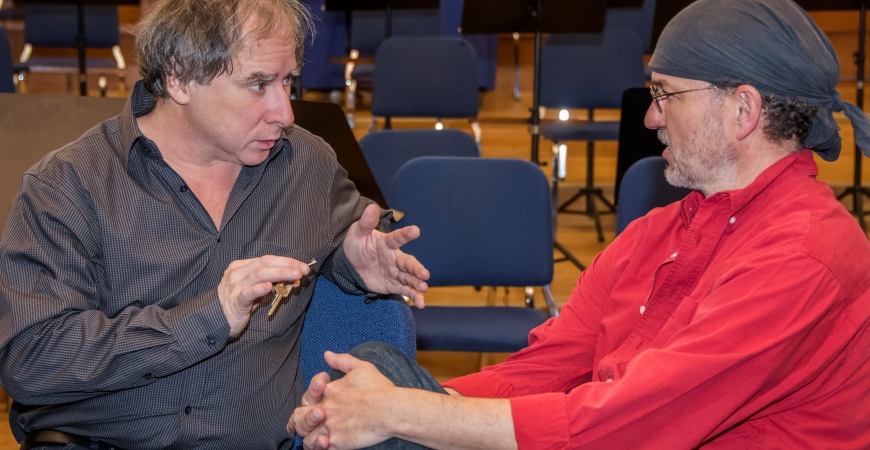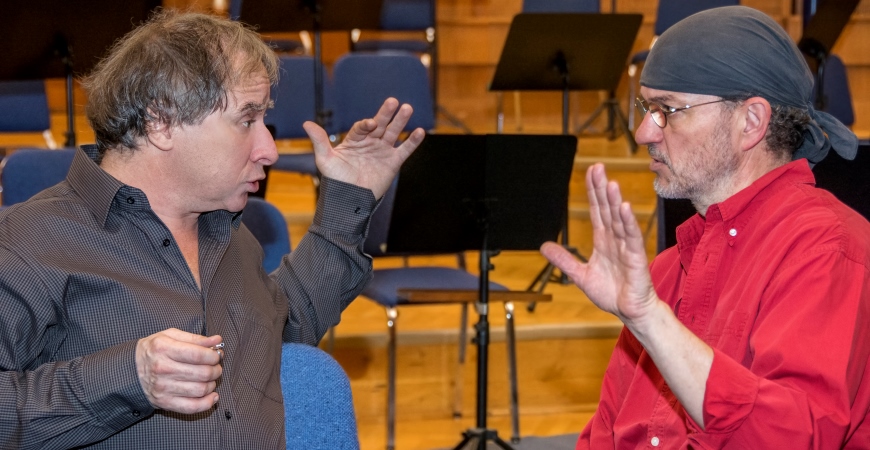Parity – András Keller & György Lakatos
Nothing better demonstrates the symbiosis of teaching and concert performing than the ‘On the Spot’ concert series, which introduces in March and April the strings & piano and woodwind chamber music groups of the Liszt Academy.
To mark this series of concerts, we chatted with violinist, founder of the Keller Quartet, director of the resident orchestra at the Liszt Academy Concerto Budapest, and chamber workshop director, András Keller, and bassoon artist and woodwind faculty director, György Lakatos, about the juxtaposition of tradition and modernity and about collaboration between faculties.
To what extent does the legendary chamber music tradition of the Liszt Academy live on today?
András Keller: Whether they like it or not, by the nature of their instruments, woodwind players need chamber music. Wind players naturally work at playing in ensembles, so they are prepared for life after graduation rather better than string students, who are not always aware they are going to spend 98 percent of their lives in orchestras and chamber groups. I regard it as a daily problem, and at present teaching at the Liszt Academy is not properly geared for this. I am very envious of what Gyuri and friends are managing to achieve.
György Lakatos: Andris is absolutely right that chamber music has been squeezed into the background in previous years. A tuba player, bassoonist or horn player may get asked to work as a soloist, but he is hardly going to make a living from it. A wind musician gets in the habit of playing in full orchestras while still at the conservatoire, and because of the repertoire they often play in trios, quartets and quintets. It is our fortune that the greatest Hungarian composers, from Petrovics to Hidas, from Ligeti to Kurtág, have written chamber works for us. By the same token, I notice that the traditional self-organisation that passed from one year to the next has died out. For this reason, I hit upon the idea of our organising a competition in April with the Debrecen University for wind quintets, to encourage the students to get together...
AK: I knew we would get to this rather quickly!
GYL: And even though we didn't plan to discuss it!

András Keller and György Lakatos (photo: Andrea Felvégi)
What do you mean by self-organisation?
GYL: I remember when I was a student, I'd go and grab, say, Keller and invite him down to the library, where we would read a score together. Or I'd find someone else to play with for a bit, then go to see Gyuri Kurtág and his lesson. When we finished our practice at eight o'clock-ish, we all went to the student gallery: it really didn't matter who was playing the piano or what orchestra was performing. We went to good and bad, and of course we went to the pub, but we wanted to hear every concert. I remember when Georg Solti came to the Erkel Theatre with the London Symphony Orchestra, we couldn't get in through the artists' entry, so we climbed through a window: Keller, Csalog, Szokolay and myself. It was our bad luck that only the window of the ladies' toilet was open. Szokolay got through, but Csalog and I were caught by the guards. Today, this self-organisational dynamism has dwindled to almost nothing, and yet without it you cannot become a musician. This magnificently restored Liszt Academy has reopened and yet concerts are not stuffed with students. (Nor, I should say, with teachers either.) I know that today we do not live in that era. They go home, actually not even home, they can go to a café, plug headphones into their mobile phone and download some music. They are not bothered by sound quality and do not know what it is like live.
AK: The world has changed. It has become much faster. Priorities have changed with the internet, which of course does not mean that today's children do not like music. Of course they do. But they search for something on YouTube, have a look, grasp what it is in general terms, but they do not listen to whole works, either from recordings or live. For today's young people, the opportunities for ad hoc music making have disappeared. The project attitude has chased out community spirit – but there is no project music. Very early on I joined the Liszt Academy orchestra, under the guidance of the legendary Albert Simon, when sometimes quietly, sometimes bellowing, he shaped the music with us. And we did the same thing at weekends with György Kurtág, as well.
It is rather problematic making spontaneity a compulsory subject.
AK: I would like the principal subjects taught at the Liszt Academy to serve a larger joint objective, which is of course hard to break down into credits, but I think it is worthwhile trying. GYL: All is not yet lost. We can fill the Liszt Academy with life, which is to say with chamber music. Because the generation which makes up today's teaching staff were participants at a young age of this particular school, the essence of which is that teachers learn and students teach.

András Keller and György Lakatos (photo: Andrea Felvégi)
Do you sense in the playing of youngsters that they have little live concert and group music experience?
KA: Young people are always good. They come to Concerto Budapest and do not know – and why should they? – how they must articulate in a Mozart symphony, what sort of bowing action to use. But in just three days, they learn by sitting next to professional musicians in the orchestra. Students learn ten times more, ten times more quickly than if they practise on their own. They are taking part in real workshop work. They pick up the pulsating rhythm unique to a professional orchestra. They are forced to, otherwise they get lost.
GYL: Perfectly true. The audience and children are never at fault, only the performer and the teacher can be bad.
Interview by Tamás Vajna, originally published in the Januar-June issue of Liszt Academy Concert Magazine.


